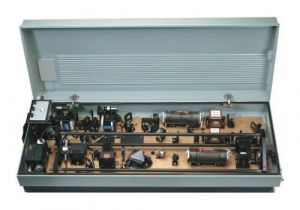Leopard series
High energy picosecond Nd:YAG laser
The new Leopard™ series of picosecond Continuum® lasers represents the cutting edge of serial systems.

Features
- With a special cavity design (serrated aperture relay imaging), it provides extremely good beam quality. Continuum® has developed this design for pumping OPG units, where the flat-top beam profile achieved is a major advantage.
- The pulse width reaches 15 ps.
- A patented resonator structure is used to enhance the excellent beam quality. (diffraction filtered unstable resonator) - US Patent # 5,065,407
- Also patented is passive negative feedback in lasers, which provides very good energy stability - US Patent # 6,546,027
- Available in three pulse widths.
Applications
The new Leopard™ series of picosecond Continuum® lasers represents the cutting edge of serial systems. The energy harvested from the amplifying medium is controlled by passive negative feedback in the oscillator, resulting in exceptionally long and stable pulse trains.
The Leopard™ D Series offers the shortest pulses without the need for a very expensive and complex regeneration amplifier. The LeopardTM SS series uses a solid-state absorber (saturable absorber) instead of a dye cell, making it much easier to handle. As a result, it is the most turnkey and affordable picosecond laser on the market.
Leopard™ Specifications
| DESCRIPTION | D-10 | D-20 | SS-10-SV | SS-20-SV | SS-10 | SS-20 |
| Pulsewidth (< psec)1 | 20 | 20 | 60 | 60 | 100 | 100 |
| Energy (mJ)2 | ||||||
| 1064 nm | 33 | 30 | 125 | 115 | 250 | 230 |
| 532 nm | 15 | 14 | 60 | 55 | 125 | 115 |
| 355 nm | 11 | 10 | 40 | 35 | 80 | 70 |
| 266 nm | 4 | 3 | 13 | 12 | 25 | 23 |
| Repetition Rate (Hz) | 10 | 20 | 10 | 20 | 10 | 20 |
| Stability (% RMS)3 | 1.5 | 2 | 2 | 2.5 | 2.5 | 3 |
| Beam Diameter (< mm) | 10 | 10 | 10 | 10 | 10 | 10 |
| Divergence (mrad)4 | 0.4 | 0.4 | 0.4 | 0.4 | 0.4 | 0.4 |
| Contrast Ratio5 | 100:1 | 80:1 | 100:1 | 80:1 | 100:1 | 80:1 |
| Jitter (± μs)6 | 10 | 10 | 10 | 10 | 10 | 10 |
| Pretrigger ( >ns)7 | 100 | 100 | 100 | 100 | 100 | 100 |
| Pointing Stability (<μrad)8 | 30 | 30 | 30 | 30 | 30 | 30 |
Notes
1. FWHM
2. Gaussian beam reduces energy specifications by 20%
3. For 1064 nm
4. Full angle for 86% of energy
5. Peak to peak with respect to residual pulses
6. With respect to lamp pulse
7. Time between cavity build up detection to light output
8. 99.9% shots will beroom
As a part of our continuous improvement program, all specifications are subject to change without notice.

